Physical Address
304 North Cardinal St.
Dorchester Center, MA 02124
Mechanical circulatory support (MCS) has become the standard of care for patients with refractory, end-stage heart failure. A landmark trial in MCS demonstrated the superiority of a left ventricular assist device (LVAD) over optimal medical therapy with respect to improving survival and quality of life in this subgroup of patients. Over the past decade, there has been a significant evolution in MCS device-related technologies. Devices have undergone substantial modifications in an effort to improve survival while on support, increase durability, and limit device-related infections, device thrombosis, device malfunction, and perioperative bleeding. With improvements in device design yielding devices that can be implanted as destination therapy, the number of durable LVAD implants has dramatically increased in the United States every year ( Fig. 97-1 ).
Current MCS devices can be divided into the following subcategories on the basis of their features: short-term versus long-term devices, paracorporeal versus intracorporeal devices, pulsatile versus continuous flow devices, full versus partial support devices, and assist devices versus complete heart replacement (i.e., total artificial heart [TAH]). The indications for implantation of a mechanical device have expanded over time to include acute cardiogenic shock, bridge to transplant (BTT), bridge to candidate (BTC), and destination therapy (DT). This chapter presents a complete overview of MCS, including a historical perspective, indications for MCS, important factors related to patient selection, types of devices, results using MCS, surgical technique, postoperative management, and complications that occur with MCS.
Dr. Michael DeBakey implanted the first mechanical assist device in 1963 in a patient with postcardiotomy shock after an aortic valve replacement. With growing interest in MCS, the Artificial Heart Program was founded in 1964. In 1966, DeBakey reported the first successful bridging to recovery with a ventricular assist device (VAD), also in a patient with postcardiotomy shock. The duration of support in this patient was 10 days.
In 1970, the Artificial Heart Program evolved into the Medical Devices Applications Branch of the National Heart and Lung Institute, with the primary focus of developing short- and long-term VADs as well as a TAH for heart replacement therapy. Dr. Denton Cooley reported the first successful bridging to transplant using MCS in 1978. In 1980, the currently named National Heart Lung and Blood Institute (NHLBI) accepted proposals by Abiomed, Baxter, Thermo Cardiosystems, and Thoratec to develop VADs and the TAH. The first successful implantation of a heart replacement therapy, a TAH with the Jarvik-7-100, was reported in 1984. However, this device was removed from clinical practice in 1991 because of a relatively high incidence of device-related complications, such as thromboembolic events and infection.
With concurrent advancements in assist device technology, the U.S. Food and Drug Administration (FDA) approved the use of a mechanical assist device as a BTT in 1994—the first of which was HeartMate (Thoratec Corp., Pleasanton, CA), developed by Thermo Cardiosystems. It soon became clear to the cardiac surgery community that implantation of LVADs could salvage patients who were otherwise nonsalvageable and could also improve the quality of life of patients with advanced heart failure.
A major victory for MCS came in 2001 with the results of the REMATCH trial. This prospective, randomized trial of patients with end-stage heart failure who were not eligible for transplantation demonstrated a significant survival advantage for patients who underwent implantation of a mechanical assist device as compared with those receiving optimal medical therapy. The study, however, also highlighted various complications of mechanical support, such as bleeding, infection, stroke, device malfunction, and development of right heart failure, which became a primary focus for device companies and engineers in subsequent years.
The emergence of newer generation VADs with a continuous flow pump driven by a rotary pump represented a further step in this field. A randomized trial demonstrated that a continuous flow pump significantly improved 2-year survival and device-related morbidity as compared with a pulsatile device. Since the approval of the continuous flow VADs for both transplant-eligible (BTT) and transplant-ineligible patients (DT), the number of patients receiving MCS device therapy has been growing rapidly.
As VAD therapy entered the mainstream, INTERMACS (Interagency Registry for Mechanically Assisted Circulatory Support)—a national registry for patients who are receiving MCS devices—was established in 2006. This registry was devised as a joint effort of the NHLBI, the Centers for Medicare and Medicaid Services (CMS), the FDA, clinicians, scientists, and industry representatives in conjunction with the University of Alabama at Birmingham and the United Network for Organ Sharing (UNOS). Analysis of the data collected is expected to facilitate further improvements in patient evaluation and management.
When considering MCS placement, five broad indications can be defined with regard to the clinical intent at the time of implantation. Complex decisions about candidacy for each strategy should be made by an experienced, multidisciplinary team including surgeons and cardiologists. This process is particularly important in ensuring appropriate selection of the patient, timing for device placement, and device to use.
BTT is a strategy for patients actively listed for heart transplant who would not survive or would develop end-organ dysfunction as a result of low cardiac output before an organ becomes available. While the patient remains on the waiting list, insertion of a durable LVAD can improve survival, functional status, and quality of life.
DT is a strategy for patients requiring long-term, lifelong circulatory support who are not eligible for heart transplant because of relative or absolute contraindications.
MCS may be used for patients who are not currently listed for heart transplant, with no absolute or a permanent contraindication to transplant. MCS may allow these patients to be eligible for transplant by improving their end-organ function and nutrition, decreasing pulmonary vascular resistance, as well as resolution of comorbidities or lifestyle-related problems (e.g., weight loss, smoking cessation).
In circumstances when a patient is in acute cardiogenic shock, it may not be possible to determine the candidacy for transplant, long-term VADs or myocardial recovery. Additionally, the patient may or may not have multisystem organ failure, and the patient's neurologic status may or may not be known. A short-term MCS may be used to stabilize the patient's condition and to assess reversibility, as a bridge to more definitive therapies. The next step can be planned while the patient is on the MCS.
MCS may be used as a temporary circulatory support to unload the ventricle. During this time, MCS use may enhance myocardial recovery from an acute injury enough to wean off the device without the need for transplant.
Careful patient selection—a critical element in achieving good clinical results with MCS—requires the evaluation of heart failure severity and the assessment of operative risk and comorbidities.
Common indicators of advanced heart failure for referral for MCS include New York Heart Association (NYHA) class IIIb-IV symptoms, frequent rehospitalizations for heart failure, or unresponsiveness to medical therapies (including neurohormonal antagonists and diuretics), recurrent/refractory ventricular tachyarrhythmia, inotrope dependence, unresponsiveness to cardiac resynchronization therapy, end-organ dysfunction as a result of low cardiac output, peak oxygen consumption less than 14 mL/kg/min, or 6-minute walk distance less than 300 m. The Seattle Heart Failure Model can be used to estimate a heart failure patient's expected mortality in the next 1 to 2 years and identify patients who might benefit from LVAD support.
The INTERMACS registry classifies heart failure patients into seven clinical profiles based on their signs and symptoms ( Table 97-1 ). These profiles also help to define illness acuity and severity and to assess the operative risk. The INTERMACS data showed that the proportion of patients in progressive cardiac decompensation (level 2) or cardiogenic shock (level 1) at the time of implantation of a durable LVAD has decreased from approximately 64% before 2011 to slightly less than 54% in 2012. This is because the patients in INTERMACS levels 1 and 2 have a 5% to 8% decrease in 1-year survival rate compared with patients in other INTERMACS levels ( Fig. 97-2 ). Generally, for patients in INTERMACS level 1, placement of a durable VAD is not recommended because these patients are often compromised by end-organ damage, uncertain neurologic status, infection, or major coagulopathy. Therefore, short-term MCS should be applied in these patients as a bridge to decision (BTD) or recovery. Conversely, patients in INTERMACS level 6 or 7 (NYHA class III) are, in general, considered “too well” for MCS placement. Currently, patients in INTERMACS levels 2, 3, or 4 are likely to be appropriate candidates for a durable LVAD implantation.
| Profile 1: Critical Cardiogenic Shock |
| Patients with life-threatening hypotension despite rapidly escalating inotropic support, critical organ hypoperfusion, often confirmed by worsening acidosis and/or lactate levels. “Crash and burn.” |
| Profile 2: Progressive Decline |
| Patient with declining function despite intravenous inotropic support; may be manifest by worsening renal function, nutritional depletion, inability to restore volume balance. “Sliding on inotropes.” Also describes declining status in patients unable to tolerate inotropic therapy. |
| Profile 3: Stable But Inotrope Dependent |
| Patient with stable blood pressure, organ function, nutrition, and symptoms on continuous intravenous inotropic support (or a temporary circulatory support device or both) but demonstrating repeated failure to wean from support due to recurrent symptomatic hypotension or renal dysfunction. “Dependent stability.” |
| Profile 4: Resting Symptoms |
| Patient can be stabilized close to normal volume status but experiences daily symptoms of congestion at rest or during ADLs. Doses of diuretics generally fluctuate at very high levels. More intensive management and surveillance strategies should be considered, which may in some cases reveal poor compliance that would compromise outcomes with any therapy. Some patients may shuttle between 4 and 5. |
| Profile 5: Exertion Intolerant |
| Comfortable at rest and with ADLs but unable to engage in any other activity, living predominantly within the house. Patients are comfortable at rest without congestive symptoms but may have underlying refractory elevated volume status, often with renal dysfunction. If underlying nutritional status and organ function are marginal, patient may be more at risk than INTERMACS 4 and require definitive intervention. |
| Profile 6: Exertion Limited |
| Patient without evidence of fluid overload is comfortable at rest and with ADLs and minor activities outside the home but fatigues after the first few minutes of any meaningful activity. Attribution to cardiac limitation requires careful measurement of peak oxygen consumption, in some cases with hemodynamic monitoring to confirm severity of cardiac impairment. “Walking wounded.” |
| Profile 7: Advanced NYHA III |
| A placeholder for more precise specification in future, this level includes patients who are without current or recent episodes of unstable fluid balance, living comfortably with meaningful activity limited to mild physical exertion. |
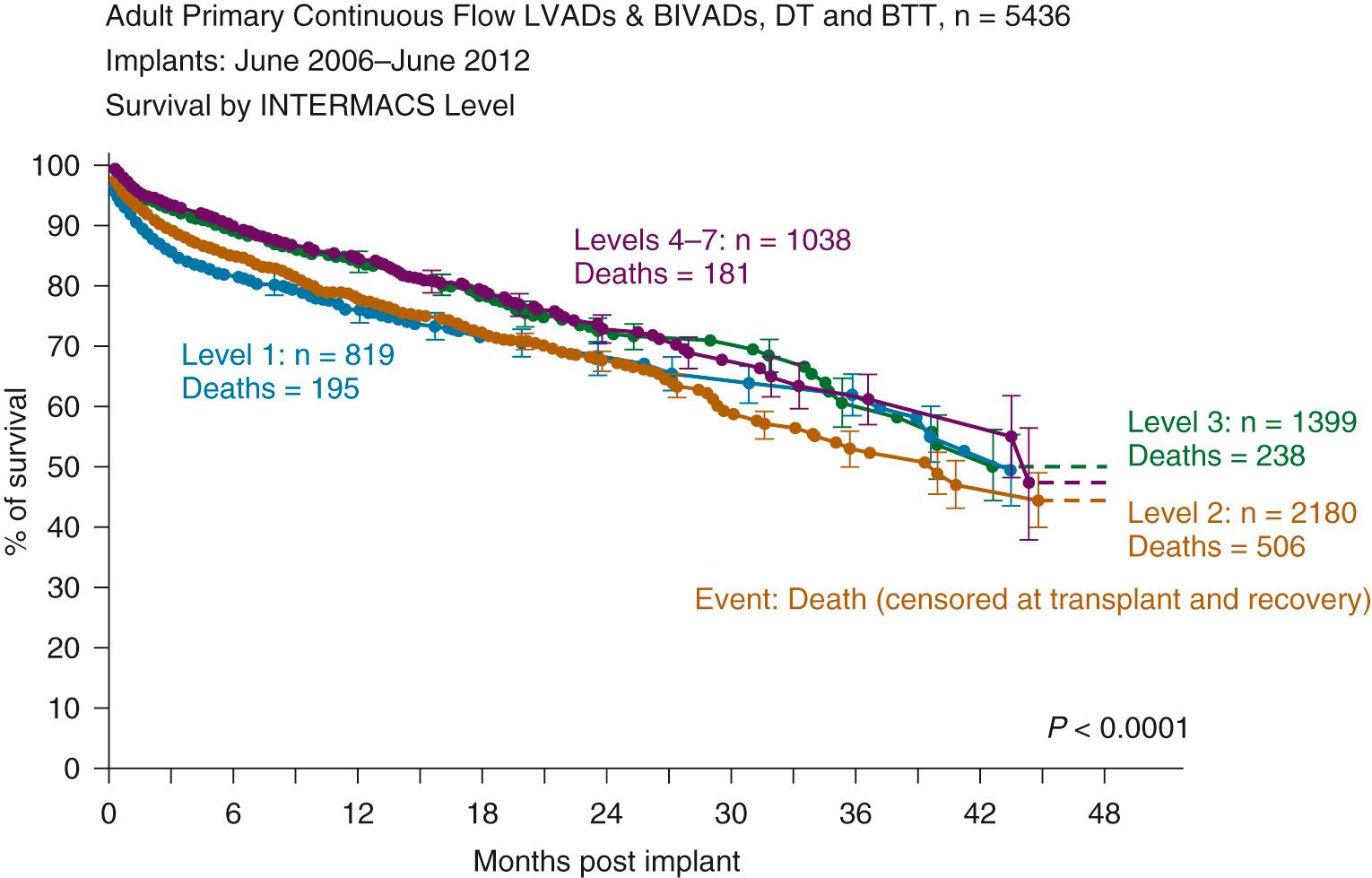
It is also important to identify those patients with significant right ventricular (RV) dysfunction before LVAD implantation, because RV failure after LVAD implantation can be a fatal complication. The implantation of an LVAD can decrease RV afterload by reducing pulmonary artery pressures. However, at the same time, increasing cardiac output with an LVAD support may increase systemic venous return to a diseased RV that may not be able to accommodate the additional volume. Furthermore, LV pressure unloading by an LVAD can cause the interventricular septum to shift leftward, leading to geometric changes in the RV that reduce RV function, exacerbating tricuspid regurgitation. The presence of depressed RV myocardial function can be determined from preoperative hemodynamic indices, including central venous pressure, pulmonary artery pressure, cardiac output, transpulmonary pressure gradient, pulmonary vascular resistance, and RV stroke work index (RVSWI). The RVSWI can be calculated using the following formula: (mean pulmonary artery pressure − mean central venous pressure) × stroke volume ÷ body surface area. Patients with high pulmonary artery pressure and normal central venous pressure (high RVSWI) are at lower risk of postoperative RV failure because the RV is able to generate sufficient pressure. A preoperative echocardiographic assessment of RV function is also important. Attention should be paid to RV dilation, contractility, and degree of tricuspid regurgitation. Numerous studies have attempted to identify the risk factors for the development of RV failure after LVAD placement. The most recent study demonstrated that preoperative predictors of RV failure after implantation of a contemporary continuous flow LVAD included central venous pressure/pulmonary capillary wedge pressure ratio of greater than 0.63, need for preoperative ventilator support, and blood urea nitrogen level greater than 39 mg/dL. Univariate predictors also included RVSWI less than 300 mm Hg × mL/m 2 , central venous pressure greater than 15 mm Hg, and elevated white blood cell count. For patients at a significantly high risk of RV failure, planned biventricular assist device placement should be indicated.
Pulmonary hypertension with an elevated pulmonary vascular resistance (>5 wood units) should not be considered an absolute contraindication to MCS. Modern selective pulmonary vasodilators such as sildenafil can reduce pulmonary pressures. In addition, patients who undergo LVAD implantation usually have improved pulmonary vascular resistance. The LVAD can be considered as a BTC in possible transplant candidates with fixed pulmonary hypertension.
Contraindications for device implantation include irreversible end-organ failure, particularly renal failure and hepatic failure, which are uniformly independent predictors of poor outcome. Severe, unrecoverable neurologic injury is also a contraindication for device implantation. Systemic sepsis poses a significant risk to patients undergoing LVAD implantation because it can cause a profound refractory vasodilatory state or lead to an increased incidence of device-related infections, such as device endocarditis.
In the pulsatile flow era, numerous studies have identified independent predictors of adverse outcome. The common denominator among these independent predictors of mortality is end-organ failure, such as respiratory failure requiring mechanical ventilation, renal failure requiring dialysis, ischemic hepatitis with markedly elevated transaminases, and diffuse coagulopathy resulting from malfunctioning clotting mechanisms. In the revised Columbia screening scale, the following clinical factors were identified as preoperative independent predictors of adverse outcome: mechanical ventilation, prior cardiotomy, prior LVAD implantation, central venous pressure of greater than 15 mm Hg, and prothrombin time of longer than 16 sec. Each factor was given a statistically weighted score, with a score of higher than 5 being associated with a 46% mortality rate and a score of 5 or lower being associated with a 12% mortality rate.
In the continuous flow era, from the analysis of 1122 patients receiving the HeartMate II as a BTT or DT, preoperative predictors of 90-day mortality were older patients, greater degree of hypoalbuminemia, renal dysfunction (higher creatinine), coagulopathy (higher INR), and implant surgery at less experienced centers. Based on the calculated risk score from these factors, mortality rates in the low, medium, and high-risk score groups were 4%, 16%, and 29%, respectively. From the INTERMACS registry data, risk factors for mortality included older age, INTERMACS level 1 and 2, DT, renal dysfunction, RV dysfunction, and surgical complexity.
Poor preoperative hepatic function has also been demonstrated to be an independent predictor of mortality after LVAD implantation. Decreased hepatic synthetic function increases the chance of developing a diffuse coagulopathy intraoperatively and postoperatively, which can cause RV failure secondary to increased transfusion requirements of blood products. The Model of End-stage Liver Disease (MELD) score calculated based on serum bilirubin, creatinine, and INR values is reported to be useful in identifying LVAD candidates at high risk for perioperative bleeding and mortality. Optimization of hemodynamics with reduction of central venous pressure and improvement of cardiac output should be pursued before LVAD implantation to improve hepatic congestion and increase hepatic blood flow.
Severe renal dysfunction was associated with a major reduction in early survival after durable VAD implantation. The incremental effect of worsening renal dysfunction was shown by assigning “moderate” renal dysfunction to patients with a creatinine level greater than 2 mg/dL or blood urea nitrogen level greater than 60 mg/dL, and “severe” renal dysfunction to patients requiring dialysis near the time of device implantation. Although renal dysfunction caused by low cardiac output or renal vein congestion generally improves after MCS placement, caution should be paid in a patient with severe intrinsic renal disease such as chronic hypertension or diabetes mellitus. Patients with end-stage renal disease requiring dialysis should not be considered for durable LVAD implantation, because of their increased risk of infection.
Preoperative nutrition status assessment is also important. Patients with cardiac cachexia are predisposed to poor healing, impaired immunity, and infection, which are generally associated with high mortality. In contrast, obesity is not a contraindication to using a continuous flow LVAD, although patients with a body mass index higher than 35 kg/m 2 are not eligible for heart transplant. These devices can provide sufficient cardiac output support to meet the metabolic demands of obese patients.
To assess the patient's ability to understand VAD care, an investigation of prior psychiatric disorders, history of drug and alcohol abuse, compliance, and cognitive function needs to be conducted. Furthermore, adequate family/caregiver, financial, and environmental support are additional factors for determining potential LVAD candidates.
Although it is important not to delay durable VAD implantation to the point of significant end-organ dysfunction, it is beneficial to optimize a relatively stable patient preoperatively. This may include hemodynamics optimization with diuretics, inotropes, short-term MCS (coagulopathy correction) with vitamin K, platelets, or fresh-frozen plasma, and nutrition management. With appropriate patient selection and timing of LVAD implantation, it is possible to achieve excellent results with relatively low associated morbidity and mortality.
Recent innovation of continuous flow technology contributes to the development of various types of short-term MCS, which can be distinguished by the method of placement (i.e., percutaneous or surgical). The current options for percutaneous circulatory support include intra-aortic balloon pump (IABP), extracorporeal membrane oxygenation (ECMO), the Impella, and TandemHeart. Surgical options include the CentriMag (Thoratec, Pleasanton, CA) ventricular support system. Each of these devices is designed for short-term use.
Insertion of an IABP was first reported by Kantrowitz in 1968. It has since become one of the most common forms of mechanical support for the failing heart. It is commonly used for high-risk percutaneous coronary intervention (PCI), acute cardiogenic shock after myocardial infarction (MI), complications after MI such as a ruptured papillary muscle, cardiotomy shock, and preoperative optimization of an MI patient who is awaiting coronary artery bypass grafting (CABG). Its mechanism of action involves inflation of the balloon in the descending aorta during diastole, which reduces afterload, increases coronary artery perfusion and pressure, improves myocardial oxygen supply, and decreases myocardial oxygen demand. Counterpulsation can be synchronized with either an electrocardiogram or an arterial waveform. Vascular complications of the IABP include femoral artery rupture, pseudoaneurysm, descending aortic dissection, as well as distal ischemia as a result of impedance of forward flow.
For patients in circulatory and respiratory failure, ECMO is a viable option. This system uses a centrifugal pump with an oxygenator and a heat exchanger in the circuit, yielding complete cardiopulmonary bypass. A venovenous ECMO is used for respiratory failure with preserved native heart function. To support the failing heart, a venoarterial (VA) ECMO is required ( Fig. 97-3 ). A VA-ECMO system can provide full circulatory support with over 4.5 liter/min flow and rapidly improve tissue oxygenation. The major advantage of this system is the quick and easy percutaneous insertion of inflow and outflow cannulas—generally via the femoral artery and vein. Major disadvantages include infection, bleeding, and complications related to vascular access. Most survival data reported with ECMO have been in the pediatric literature. The Extracorporeal Life Support Organization (ELSO) registry has accumulated data on more than 50,000 ECMO cases from more than 220 ECMO centers worldwide, including approximately 2300 cases of adult cardiac failure. In 2012, ELSO reported a survival to discharge rate of 39% for adult cardiac failure. No meta-analyses of ECMO or randomized control trials with a mortality endpoint have been published. However, the ECMO system is likely to have the greatest potential for wider clinical use as a short-term MCS in cases such as cardiogenic shock.
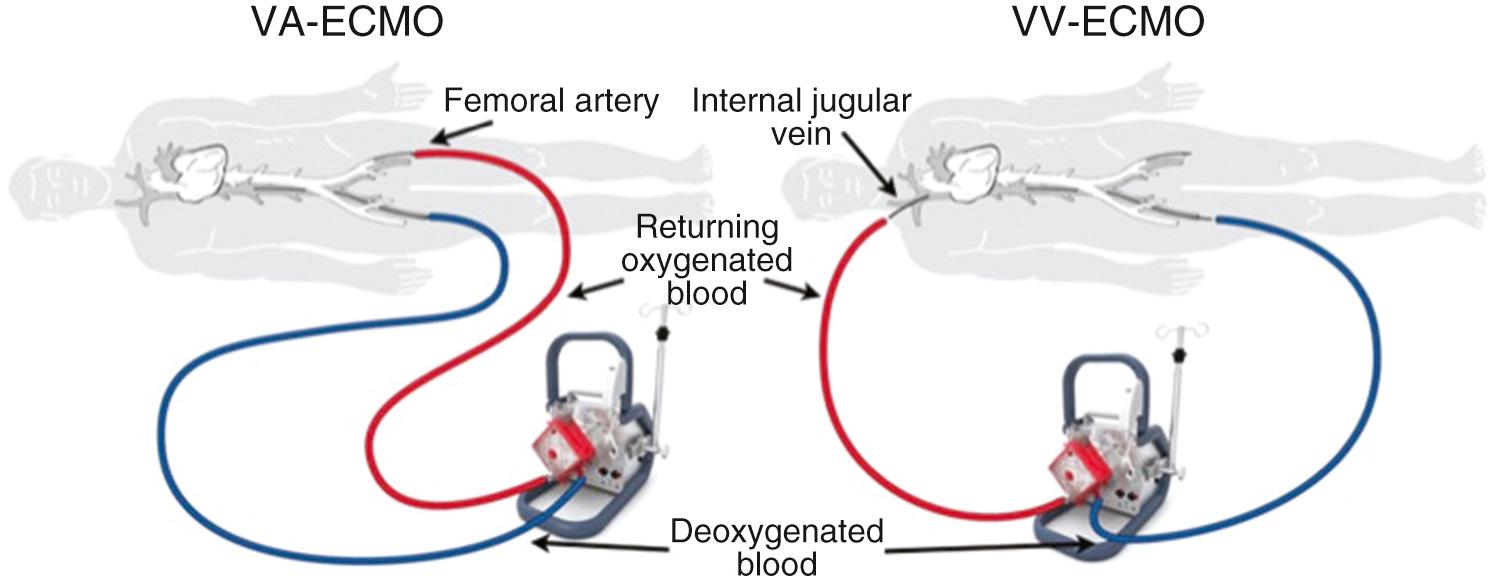
The TandemHeart (CardiacAssist, Inc., Pittsburgh, PA) is another percutaneously inserted device that uses a centrifugal pump. Two cannulas are inserted percutaneously with inflow from the left atrium—via a trans-septal puncture from a catheter entering from the femoral vein to the inferior vena cava to the right atrium and left atrium, and across the interatrial septum—and outflow into the femoral artery ( Fig. 97-4 ). The pump can deliver flow rates up to 5.0 liter/min at a maximum speed of 7500 rpm. The initial clinical experience with this device for patients with high-risk PCI and post-MI cardiogenic shock has been favorable compared with IABP. Subsequent reports demonstrated the TandemHeart circulatory support led to improvement in cardiac index, decrease in pulmonary capillary wedge pressure, and recovery in end-organ function. However, no randomized control trial with a mortality endpoint has been conducted. The popularity of this device may be limited because of its relatively complex mode of insertion requiring trans-septal puncture.
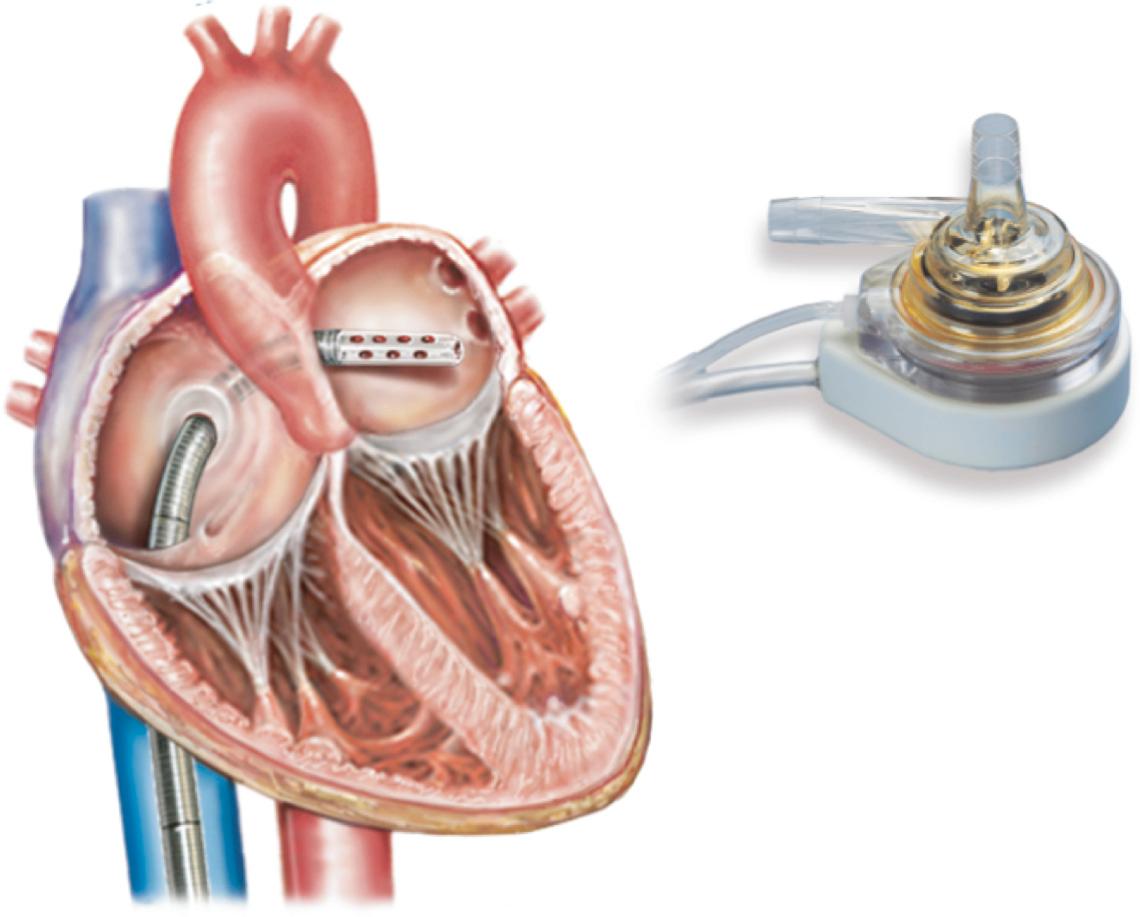
The Impella is an intravascular microaxial rotary pump that can be inserted across the aortic valve to provide forward blood flow from the left ventricle into the ascending aorta. The family of the Impella system includes 2.5, CP, 5.0, LD, and RP ( Fig. 97-5 ).
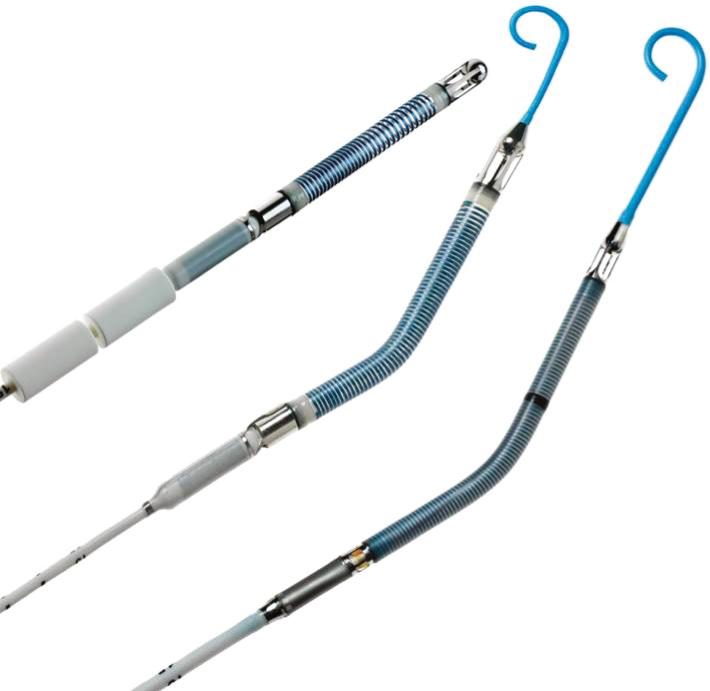
The Abiomed Impella 5.0/LD—providing flow up to 5 liter/min—is inserted by a cardiac surgeon into the ascending aorta or a peripheral artery, such as the femoral or axillary artery. It is used for acute cardiogenic shock or postcardiotomy shock. Preliminary reports demonstrated a better survival benefit with implantation of the Impella than with an IABP for patients with postcardiotomy shock. A subsequent multicenter prospective trial demonstrated that the use of the Impella 5.0/LD in patients with postcardiotomy shock yielded favorable outcomes.
The Impella 2.5 is a minimally invasive cardiac assist device that is usually inserted by an interventional cardiologist percutaneously through the femoral artery up the descending aorta, across the aortic arch, down the ascending aorta, and across the aortic valve into the left ventricle. This is generally performed under either echocardiographic or fluoroscopic guidance. This device can provide flow up to 2.5 liter/min, giving partial circulatory support, and is relatively easy to implant. Clinical trials, focusing on high-risk PCI and acute MI cases, have suggested that the Impella 2.5 may provide superior hemodynamic support compared with the IABP. However, similarly to the ECMO and TandemHeart, no conclusive data with mortality as an endpoint are available for the Impella pump family.
The Impella CP has recently become clinically available in the United States. With a maximal flow of 3.5 liter/min, it may overcome the flow limitations of the Impella 2.5.
The Impella RP is specifically designed for RV support and is currently undergoing a clinical trial.
The HeartMate PHP (percutaneous heart pump; Thoratec, Pleasanton, CA) is an investigational device with a catheter-based axial flow pump ( Fig. 97-6 ). Its collapsible elastomeric impeller and nitinol cannula allow for percutaneous insertion. The system can generate 4 to 5 liter/min of flow. It successfully completed the first-in-man phase in 2013 for adjunctive hemodynamic support during a high-risk PCI, with clinical trials planned for 2014.
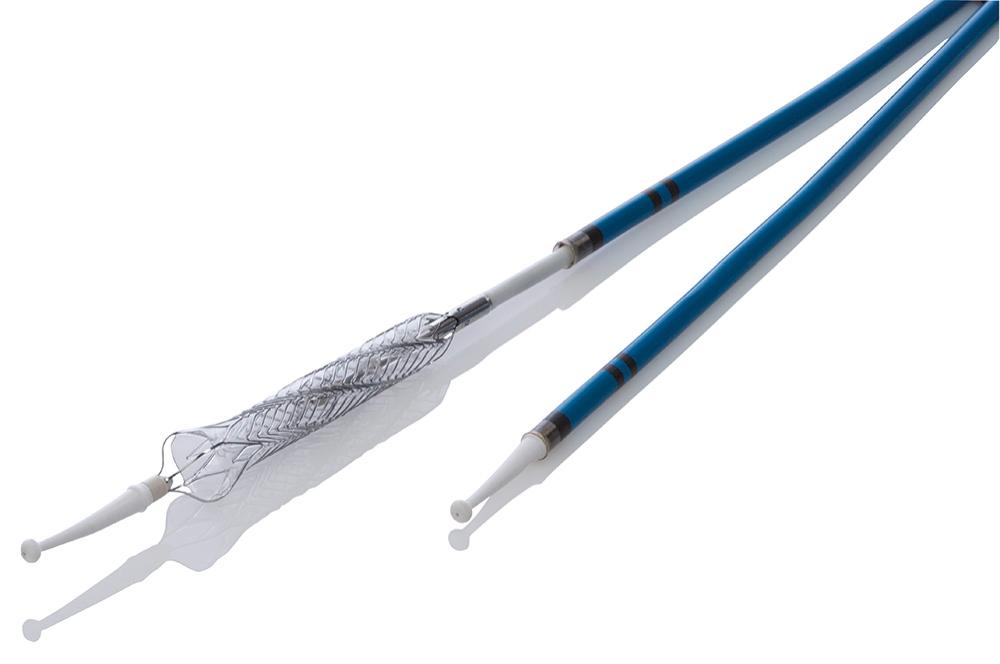
The Abiomed BVS 5000 is a dual-chambered, pneumatically driven, extracorporeal pump that can be used for short-term support as a univentricular or biventricular assist device. The device is capable of flowing up to 6 liter/min. Many series have reported acceptable results with this device.
The Abiomed AB5000—the next-generation device after the BVS 5000—is fully automated and has a vacuum-assisted console. Advantages of this device over its predecessor include allowing patients to be more mobile and extending the duration of device support.
The CentriMag blood pump (Thoratec, Pleasanton, CA) is an extracorporeal centrifugal pump that is FDA approved for up to 6 hours of support time, operating without mechanical bearings or seals. The system combines the drive, magnetic bearing, and the rotor function into a single unit ( Fig. 97-7 ). The rotor is magnetically levitated, which enables the device to rotate without friction or wear, and eliminates heat production. This serves to minimize trauma to the blood and avoids mechanical failure. Because the rotor surface is uniformly washed, blood stagnation and turbulence in the pump are minimized. Hemolysis is reduced because the mechanical gaps in the pump are wider than 0.6 mm, reducing shear forces. The device can produce flows of up to 10 liter/min with a priming volume of 31 mL.
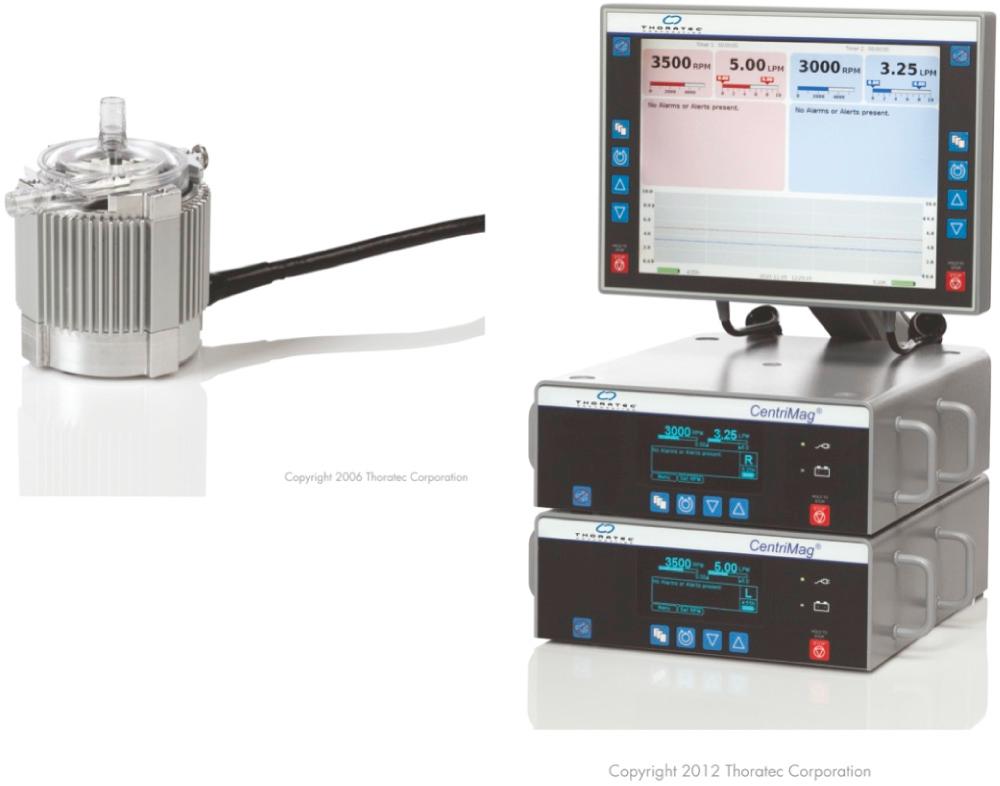
Implantation of a CentriMag is less technically challenging and faster than implantation of other devices. The cannulas are inserted using techniques similar to those used for routine cannulation in cardiopulmonary bypass. Another particularly useful feature of the device is the ease of adjustment of the device speed and resulting flow. Based on the patient's clinical scenario (i.e., to increase flow during periods of sepsis and decrease flow when attempting to assess weanability from the device), the speed of the device can be increased or decreased simply by pushing a button. This system can provide isolated left ventricular support as an LVAD, isolated right ventricular support as a RVAD, or biventricular support as a full-support biventricular assist device (BiVAD). BiVADs allow decompression of both ventricles, restore hemodynamic stability, provide enhanced peripheral perfusion, and prevent end-organ dysfunction. The CentriMag is a rescue device that can be surgically implanted in patients with acute refractory cardiogenic shock.
Become a Clinical Tree membership for Full access and enjoy Unlimited articles
If you are a member. Log in here